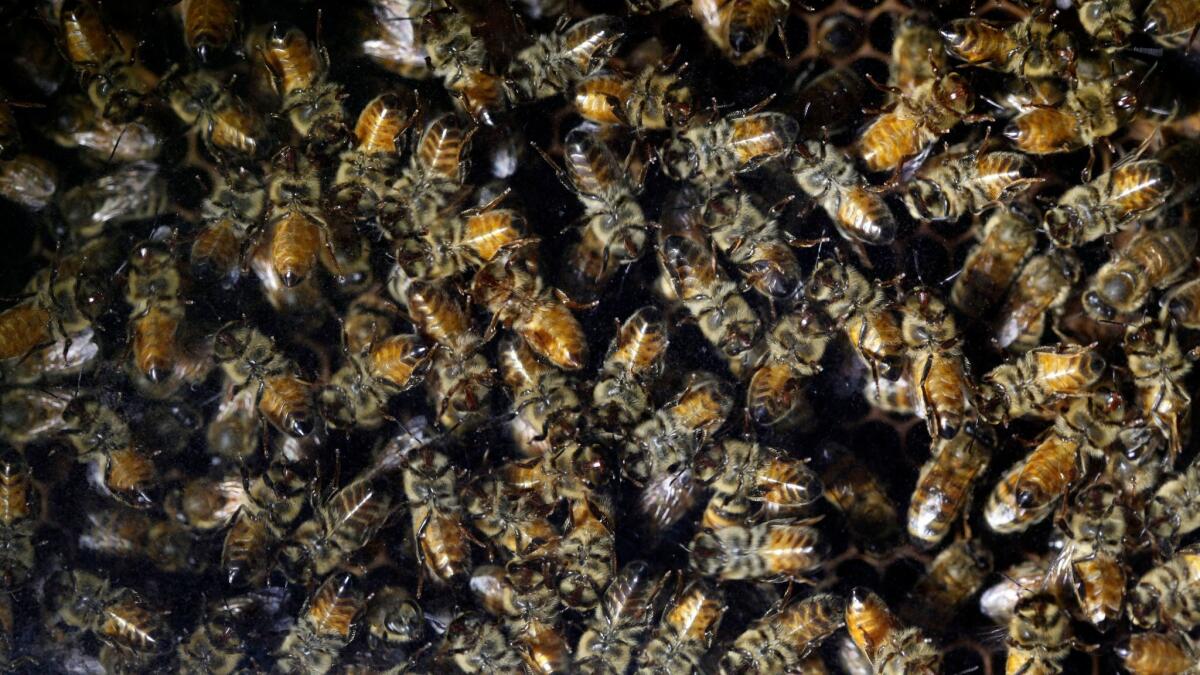EPA’s bee decisions are sweet for growers, but they sting environmentalists

The U.S. Environmental Protection Agency backed away from tough restrictions on how pesticides can be used while honeybees are pollinating crops, and it declared that three of the pesticides most closely associated with bee deaths are safe in most applications.
The assessments, released late Thursday, conclude that clothianidin, thiamethoxam and dinotefuran can kill bees and their larvae individually, but that in “most approved uses” they “do not pose significant risks to bee colonies” at the exposure levels expected to be found on fields.
Those conclusions are likely to allow growers to keep using the chemicals — which are ingredients in dozens of products — to protect millions of acres of soybeans, corn, cotton, vegetables, fruit and nuts, including 439,000 acres in California.
But the documents were a double disappointment to environmentalists, who say scientific studies support bans or at least enforceable restrictions on the chemicals’ use.
“It’s outrageous that on the same day the EPA acknowledged these dangerous pesticides are killing bees it also reversed course on mandating restrictions on their use,” said Lori Ann Burd, director of the Center for Biological Diversity’s Environmental Health program. “This is like a doctor diagnosing your illness but then deciding to withhold the medicine you need to cure it.”
Tiffany Finck-Haynes, food futures campaigner at Friends of the Earth, said the bee policy “fails pollinators” and should have been strengthened.
“If EPA is serious about protecting bees, the livelihood of beekeepers and our environment, the agency should take bee-toxic pesticides off the market,” she said.
This is like a doctor diagnosing your illness but then deciding to withhold the medicine you need to cure it.
— Lori Ann Burd, Center for Biological Diversity
The federal agency also released an assessment Thursday of how a fourth chemical, imidacloprid, affects aquatic life; a study of imidacloprid’s effect on bees was released last year. All four are in a category known as neonicotinoids, which have been linked to a precipitous decline in bee colony populations since 2006.
The moves came as the EPA prepares for its transition to the Trump administration. President-elect Donald Trump’s pick to head the agency, former Oklahoma Atty. Gen. Scott Pruitt, has sued the agency over its enforcement of the Clean Water Act and other regulations.
Read more: Trump names climate change skeptic and oil industry ally to lead the EPA »
The risk assessments will form the scientific foundation for labeling requirements on the chemicals under federal pesticide laws, expected to be completed next year. Those rules are strictly enforceable, and the process of writing them is closely watched by growers, the agrochemical industry and environmentalists.
The EPA’s bee policy likewise rests on the risk assessments, which define which chemicals are known to be toxic to bees and at what exposure levels. But the bee policy is not enforceable. It suggests that users avoid spraying the toxins when commercial hives have been brought in to pollinate blooming flowers. Those pollination services contribute about $14 billion in value to the agricultural economy nationwide.
The EPA loosened the bee protection policy from an earlier draft in response to criticism from growers, who argued that not every chemical lingers in the environment for the same amount of time and that not every crop has the same bloom period.
The agency now will offer more flexibility in how growers apply chemicals whose toxic effects dissipate quickly, and to factor in circumstances such as whether they are applied at times when the bees are unlikely to be foraging.
Use of the four chemicals, especially imidacloprid, has been rising in California, said Charlotte Fadipe, spokeswoman for the state Department of Pesticide Regulation, which helped the EPA on the assessments.
”As we learn more about the scientific effects on bees, it is likely that California will impose some kind of restrictions on the use of neonicotinoids on certain crops by the end of this year,” Fadipe said.
The EPA will be accepting comments on the documents for 60 days before finalizing them.
Follow me: @LATgeoffmohan
ALSO
California farm labor board chairman quits in anger
Why cheaper food in 2016 was not necessarily good news
Chicken industry pushes against movement that wants svelter, slower-growing birds
More to Read
Inside the business of entertainment
The Wide Shot brings you news, analysis and insights on everything from streaming wars to production — and what it all means for the future.
You may occasionally receive promotional content from the Los Angeles Times.











